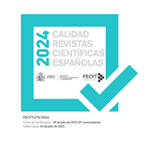Análisis del tratamiento de había cantado en materiales didácticos de ELE. Descripción, uso e interrelaciones
Resumen
El objetivo de este artículo es analizar el tratamiento que del pretérito pluscuamperfecto de indicativo se realiza en un corpus de 55 gramáticas y manuales de ELE. Constatamos la diversidad de definiciones y usos que se explicitan en las distintas obras. Así, determinamos cómo se plantea su tratamiento didáctico a partir del análisis de la variación terminológica de sus denominaciones, las definiciones y usos e interrelaciones establecidas con otros tiempos verbales y la presencia de adjuntos temporales, sin olvidar la ejemplificación empleada para llevar a cabo su ilustración. Como resultado, se comprueba, no solo la naturaleza relativa y relacional de la forma verbal que nos ocupa, sino también la escasa carga metalingüística existente en gramáticas y manuales de ELE, muy especialmente en manuales pertenecientes al enfoque comunicativo. Partimos del hecho de que en la enseñanza-aprendizaje del español es imprescindible atender a la forma (Long, 1991 y 1997), por lo que el conocimiento gramatical de las formas verbales y la reflexión metalingüística redundará de forma determinante en el éxito del proceso de aprendizaje.
Descargas
Descarga artículo
Licencia
La revista Círculo de Lingüística Aplicada a la Comunicación, para fomentar el intercambio global del conocimiento, facilita el acceso sin restricciones a sus contenidos desde el momento de su publicación en la presente edición electrónica, y por eso es una revista de acceso abierto. Los originales publicados en esta revista son propiedad de la Universidad Complutense de Madrid y es obligatorio citar su procedencia en cualquier reproducción total o parcial. Todos los contenidos se distribuyen bajo una licencia de uso y distribución Creative Commons Reconocimiento 4.0 (CC BY 4.0). Esta circunstancia ha de hacerse constar expresamente de esta forma cuando sea necesario. Puede consultar la versión informativa y el texto legal de la licencia.











